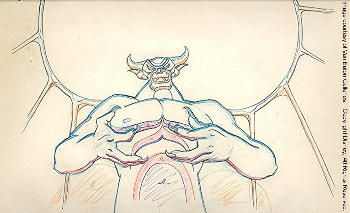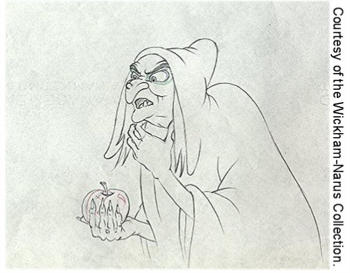Rhett Wickham: Boo Who?
Page 2 of 3
RHETT WICKHAM
Dr. Mathis, I�m wondering if it�s reaching to say that animated characters such as the Wicked Queen in �Snow White and the Seven Dwarfs� and Ursula the Sea Witch in �The Little Mermaid� still have value because they let us enjoy the thrill of how they frighten us and yet still feel we have some power of the fear they instill. Are they more effective than say characters like Hannibal Lecter or the murderous American businessman in Hostel, who suffer from socially deviant behavior that is very real and over which we feel extremely helpless in real life?
DR. ANDREW MATHIS
Absolutely, and that�s why the so-called phobic-object fairy tales are so fascinating, because it gives the child and the child in us adults a chance to re-experience some of the fear over which we have gained control. It�s a mastery gaining experience to renew it. (A simplified example of phobic-object would be a child playing with a plush toy when a loud noise comes from behind and scares him, so he then avoids all plush toys because he associates the object with the fear.) We like to master fear, and fear is not something we like by nature. When we can do something that makes us feel as if we have mastery over fear then we like to experience that over and over and over.
RW
So fairy tale or animated villains do have more value than the more graphic violence?
AM
Oh absolutely, absolutely. This graphic stuff, I think, adds to massive denial and or a pervasive anxiety that finds drugs are the easiest way out, rather than working it out as a mythological thing. That goes on with all kids. Kids are weak. They look at these �giants� around them (referring to adults), they�re helpless around them, totally dependent upon them, so they internalize what the big giants think, feel, like, so they can please them and not get hurt. But they�re always scared they might get hurt, because kids make mistakes all the time, so we have these scary feelings and so these wicked witches or other evil fairy tale figures through whom we can re-experience the fear but come out safe. It�s a kind of healing experience. It�s like some of the mythology and some of the religions � they want to go through the experience time and again.
RW
Do you think there�s any real danger or harm to either adults or children to being exposed over and over to the more realistic images of torture and violence?
AM
I think the temperament of kids varies. With some kids I have no doubt about it. Some kids at the ages of 3 and 4, particularly, they see something bloody and gory and it can really frighten them � enough to give them nightmares for quite a while.
RW
In so many contemporary films, and countless video games, there seems to be a demand for more and more graphic violence, and a resulting tolerance for the violence.
AM
I haven�t been playing with video games much, there are more important things that I�m interested in (he laughs) but I get glimpses of it. I think they get more and more graphic because the appeal of it is to gain more mastery. And the more mastery you gain over killing and gore and putting your life on the line, the more removed you are for empathy and pain and what makes a wholesome life.
RW
So you think it does have a detrimental effect on our ability to express empathy?
AM
Oh I think so. You get hardened to violence. I�ve been watching the recent documentaries on World War II and what happened to some of these soldiers. The first time a guy shoots somebody he may vomit. I remember seeing one where one pilot, his buddy got shot, and he had to both fly the plane and shoot, and he ended up shooting so many German soldiers that his hand went completely numb and he couldn�t shoot any more. Hell, yes, this has a detrimental effect. The buzz word now is post-traumatic stress. Well, I think there are very few of us who don�t have a bit of post-traumatic stress from some event along the way in our life. It makes me shudder to think about it.
RW
Why is it that we didn�t see so much of this until the last few decades? It seems to me that we�re seeing more and more of it. Is it an addictive response?
AM
Oh it is, in a way, addictive if you consider what�s happened in the world, particularly in the United States since mid-century. We went through World War II, we went through the Korean War, we went through Viet Nam � which was a horrible period. I saw a number of vets in the VA hospital following World War II and Korea, and what these guys were going through is pretty rugged. They called it battle fatigue and various things of that sort back then, and nowadays it�s referred to as post-traumatic stress. These things hang on. Once you get generation after generation after generation going through wars and having kids, something happens between parent and child, I think. Here you have these kids looking at their daddies and their mommies as heroes, which they are in their own sense, and protectors, and they want to imitate them. So they put themselves �in the battlefield� where the blood is. The business people all over the globe are grabbing on to this and mopping up with it.
� • �
I was struck by Dr. Mathis�s last comment in particular. We forget the cumulative effect of violence on a national psyche. Consider, for instance, the way audiences in the 1930�s perceived the villains that haunted the screen before America entered the Second World War. Walt himself was a medic in the fields at the close of the First World War, then simply known as the Great War or the War to End All Wars (if only.) Surely, it was different for a young man coming back from that war, looking for a way to renew his hope and fulfill his dreams in an America in which he might have greater opportunity. As a native son, Walt already had a taste of hope that was the stuff of myth over seas. The influx of European immigrants in post World War I at least hints to the common pursuit of something better after such a terrible conflict. It wasn�t that long before native and immigrants alike had forgotten the atrocities of war and were preoccupied by the economic threat of the depression. By the time America came out of the depression, Walt Disney had already established himself as a powerful peddler of optimism. So it is that Snow White�s evil Queen, later disguised as a wicked witch, held great sway on the dreams of children and adults alike; here was a seldom seen living nightmare, and the antithesis of maternal affection that characterized a more na�ve America seventy years ago.
Next came Pinocchio, who encounters countless temptations and threats, each one an archetype on the road to maturity; not just physical and emotional maturity of the individual, but the maturity of a nation as well. By the time the Chernabog swept his hand across the ancient rooftops of that sleepy medieval village, the World, or every one in the World except America, was at War, and in less than a year following the release of Fantasia, America could no longer afford � literally or figuratively � to ignore how the landscape had changed. Villainy had a new name, and he was more cruel, more soulless and more frightening than anything movies could manifest. Above all else, Hitler, Mussolini and Hirahito were very, very real.

Click here for a much larger version of this picture

Click here for a much larger version of this picture
